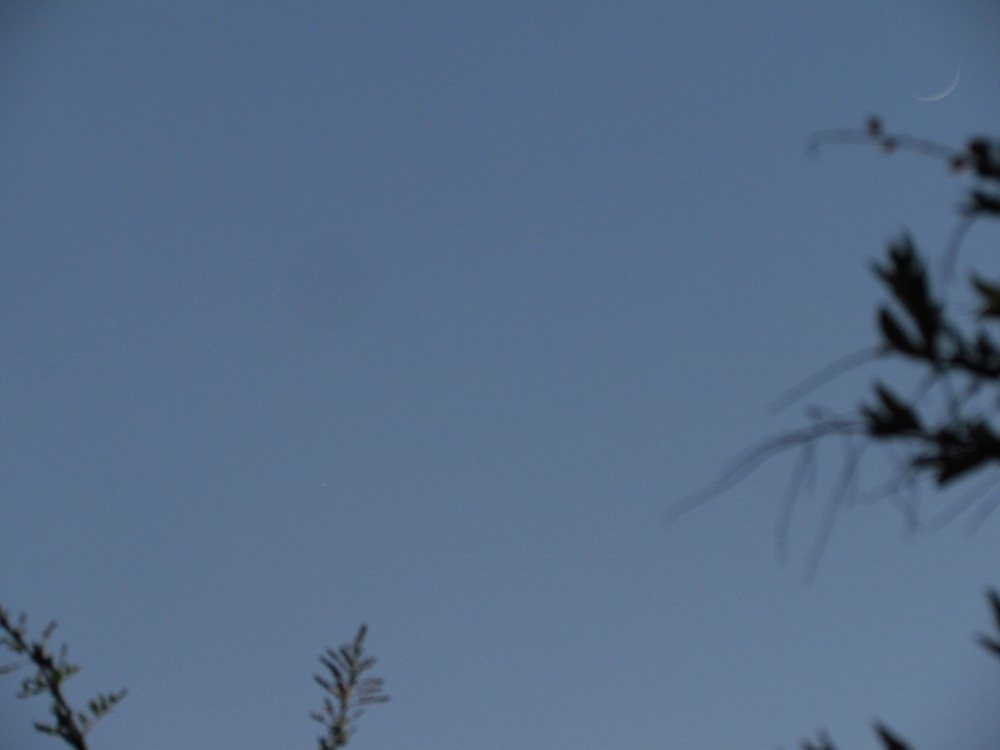[/caption]
The planet Venus is so bright that when conditions are right, it can be visible in full daylight. This weekend, and especially on Saturday, February 25, 2012, conditions should be just right for seeing Venus in the daytime. Our friend Gadi Eidelheit sent us his tips for seeing Venus, and says it is easier to see Venus when it is far from the Sun and less affected by its glare, so make sure that the Sun is blocked by a building or a tree. If you have a clear blue sky in your location early Saturday afternoon, try first locating the crescent Moon at about 1 pm local time. At this time, the Moon will be in the southeastern sky, about 60 degrees above the horizon.
When you find the Moon, look a short distance directly below it to find Venus. The planet will appear as a tiny white dot in the sky. You can also use sky maps or internet sites (such as Heavens-Above) to find out where Venus is relative to the Moon.
If you don’t see Venus during the day, try to see Venus immediately at sunset; and right now, the Moon, Venus and Jupiter are lining up for triple conjunction at dusk, and with clear skies, it will be a great view that is almost impossible to miss!
But for seeing Venus on subsequent days, try to stand in the same position where you saw it before, but 20 minutes before sunset. Try to locate Venus a little higher up and to the East from where it was a day before. Do so for several days, each time a little earlier.
You can also try to use binoculars to locate Venus. Safety first, make sure that the Sun is completely blocked and that you can not accidentally look directly at it through the binoculars! Although Venus is bright, it will not appear through binoculars if they are not focused properly. In order to use binoculars, focus it beforehand (such as the evening before) on Venus and make sure that the focus does not change. Now the binoculars are focused and you can use them to see Venus in the day. After you find Venus through the binoculars, try to see it without them.
If you get images of Venus in the daytime or of the triple conjunction, you can submit them to our Flickr page.
If your location does not have clear skies for the triple conjunction, The online Slooh Space Camera will webcast views from various observatories around the world, beginning at 0230 GMT (9:30 pm EST, 6:30 pm PST) both nights this weekend (Feb. 26 and 27). Access the webcast here.
Slooh will provide footage from multiple observatories around the world, including Arizona and the Canary Islands off the coast of Africa. The broadcast can be accessed at Slooh’s homepage, found here: http://events.slooh.com/
Frederick Quintao on Google+ has provided instructions for seeing Venus in the daytime in Portuguese!


Does anyone know how often Jupiter, Venus and the Moon are in alignment like this? I saw it this evening and it was quite the sight! Wondering if I might see it again someday
I would imagine quite frequently, as Jupiter passes through conjunction with the Sun every 13 months or so, and would necessarily appear quite close to Venus at some time during this, although not every time would be advantageous from any specific part of Earth. Also, both might be too close to the Sun to view at all.
Thanks! I’ve seen it today quite easily at 15:30 local time.
Thanks for this article. I caught this today at about 12:55PM. I even got a few nice pictures of it.
Despite enlarging the above photograph I am unable to positively view Venus in any shape or form is anyone else encountering this difficulty? if you can identify it what is its position relative to the two upright tree branches at lower left?
Attempting to locate Venus with binoculars or telescope while the Sun is in the sky is fraught with danger and truly not worth the risk therefore please heed Nancy’s safety advice.
Venus shows above the second branch from the left as a very fuzzy dim spot.
1. Use the full length of that branch as a ruler.
2. Locate a line through the center of that branch, and add 2 full lenghts from the bottom of the photo.
Thanks Magnus for the celestial directions, upon careful scrutiny with a magnifying glass Venus remains totally elusive must be age related diminishing eyesight!
She can be a bitch *oops*
Ok, here it is: http://imm.io/hqID
It’s very elusive unless you know where to look at.